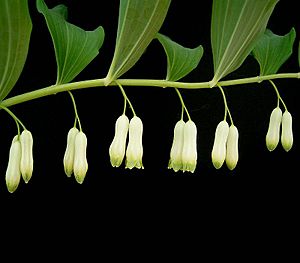Polygonatum facts for kids
Quick facts for kids Polygonatum |
|
|---|---|
 |
|
| Polygonatum multiflorum | |
| Scientific classification |
|
| Kingdom: | Plantae |
| Clade: | Tracheophytes |
| Clade: | Angiosperms |
| Clade: | Monocots |
| Order: | Asparagales |
| Family: | Asparagaceae |
| Subfamily: | Nolinoideae |
| Genus: | Polygonatum Mill. |
| Synonyms | |
|
|
Polygonatum (say it: pol-ih-GON-uh-tum), also known as King Solomon's-seal or Solomon's seal, is a genus of beautiful flowering plants. These plants are found all over the cooler parts of the Northern Hemisphere, especially in Asia. There are about 63 different kinds, and 20 of them grow only in China. In the plant world, Polygonatum belongs to the Asparagaceae family, which also includes asparagus!
Contents
What's in a Name?
The name Polygonatum comes from ancient Greek words meaning "many knees." This name describes the plant's underground stem, called a rhizome, which has many joints, like knees.
The common name "Solomon's seal" has a few interesting stories. One idea is that the scars left on the roots, where old stems used to be, look like royal seals. Another idea is that the cut roots look like Hebrew letters.
Plant Description
Polygonatum plants usually have arching stems with leaves arranged along them. Their flowers often hang down in small clusters. After the flowers bloom, they produce small, round berries. These berries can be red or black, adding a splash of color to the plant.
Different Types of Solomon's Seal
There are many different types of Polygonatum plants around the world. Some well-known ones include:
- Polygonatum biflorum, found in North America.
- Polygonatum humile, a smaller type from Eastern Asia.
- Polygonatum multiflorum, a common type found in Europe.
- Polygonatum odoratum, known for its pleasant smell.
- Polygonatum verticillatum, which has leaves arranged in a circle, or "whorl."
These different species show how varied the Polygonatum genus is, with each type having its own unique features.
How People Use Solomon's Seal
Gardening and Beauty
Many types of Polygonatum are popular ornamental plants. This means people grow them in their gardens because they are pretty to look at. They are often chosen for shady spots in gardens because they can grow well without a lot of direct sunlight. Some popular garden varieties include:
- Polygonatum biflorum
- Polygonatum hookeri
- Polygonatum humile
- Polygonatum multiflorum
- Polygonatum odoratum
- Polygonatum verticillatum
Food Uses
For a long time, people in China have used many Polygonatum species as food.
- The leaves, stems, and rhizomes (underground stems) can be eaten raw or cooked. They are sometimes served as a side dish with meat and rice.
- During festivals, the rhizomes of some local species are eaten with chicken's or pig's feet.
- The rhizomes are also used to make tea or soaked in wine or other drinks to add flavor.
- They can even be fried with sugar and honey to make sweet snacks!
- The starchy rhizomes can be dried, ground into powder, and added to flour to help make food staples.
- The rhizome of P. sibiricum is used to make a sweet liquid seasoning called tangxi.
- In the past, people in China sometimes relied on P. megaphyllum as a famine food when other foods were scarce.
In other parts of the world:
- The young shoots of some Polygonatum plants can be boiled and eaten like asparagus.
- P. cirrifolium and P. verticillatum are used as leafy vegetables in India.
- The American species P. biflorum has a starchy root that was eaten like a potato and used to make flour for bread.
- In Korea, P. sibiricum is used to make a tea called dungulle.
Traditional Medicine Uses
Some Polygonatum species have been used in traditional medicine for a long time.
- In 1930, a scientist named Hedwig Langecker noticed that Polygonatum was used to help with diabetes. She found it could help control high blood sugar levels that come from food.
- P. verticillatum is used in Ayurveda, a traditional Indian medicine system, to help with pain, fever, swelling, allergies, and weakness.
- In traditional Chinese medicine, a mix of Polygonatum species is used as an herbal remedy called rhizoma polygonati. It is believed to make different body parts stronger and improve a person's qi (life energy). It's also thought to help the mind feel better, especially when someone is tired or stressed.
Images for kids
See also
 In Spanish: Polygonatum para niños
In Spanish: Polygonatum para niños




